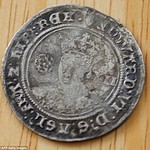
PREV ARTICLE
NEXT ARTICLE
FULL ISSUE
PREV FULL ISSUE
NUMISMATIC VOCABULARY: TERMINUS POST QUEMIn the April 10, 2014 email of her
CoinsWeekly newsletter, Ursula Kampmann tackles a topic
very important to the interpretation of buried coin finds -
‘terminus post quem’. The principle is straightforward, yet
ignorance of it has led to many a fanciful theory with no basis
in fact. Here's a compilation of her writing. -Editor
do you know what the technical term ‘terminus post quem’ means? My old prof of prehistory drilled this term into my brain. A terminus post quem is the moment after which something must have been buried in the earth. I’ll give you a simple example. You go to your garden because you want to work it on this wonderful spring day. In your pocket you carry some change. Suppose you live in Switzerland. In that case you may have with you 50 rappen from 2007, 10 rappen from 1978 and even 20 rappen from 1896 – all coins which can still be found in circulation. Let’s further suppose that in some 500 years an archaeologist will happen to find a little coin hoard composed of exactly these three coins because you will lose them in your garden today. And what will he deduce from the years of issue of these three coins? If he is smart – nothing. Only that the coins must have been dropped after the year 2007 – the terminus post quem. The year of production does not tell us anything about the time when something was buried in the ground. And in order to stress this point, there is no need to refer to the well known Swiss collector who buried in his garden a small hoard of Sasanian coins just to make the life of future archaeologists a bit more thrilling. Maybe the politician that argues for an English expedition to Canada should have attended lectures with my old prof. I've long understood the principle, but
until now didn't know there was a name for it. Thank you,
Ursula! -Editor
To read the complete article Ursula was introducing, see: Can a coin rewrite Canada’s history? (www.coinsweekly.com/en/News/4?&id=2669) Here's a relevant quote from an article on
the topic Ursula references in Skeptical Humanities.
-Editor
The takeaway of all this, I think, is that the breathless reporting of a single find that overturns the entire known history of a region is to be taken with a grain of salt in much the same way we should avoid concluding that a single observation should completely overturn decades of established science. Of course, it is tempting for a journalist to report the bigger, slightly more sensational story... To read the complete article, see: Shilling for Big History (skepticalhumanities.com/2014/03/11/shilling-for-big-history/) To read the earlier E-Sylum article, see: EDWARD VI SHILLING FOUND VICTORIA, BRITISH COLUMBIA (www.coinbooks.org/esylum_v17n10a23.html) Wayne Homren, Editor The Numismatic Bibliomania Society is a non-profit organization promoting numismatic literature. See our web site at coinbooks.org. To submit items for publication in The E-Sylum, write to the Editor at this address: whomren@gmail.com To subscribe go to: https://my.binhost.com/lists/listinfo/esylum All Rights Reserved. NBS Home Page Contact the NBS webmaster 
|
